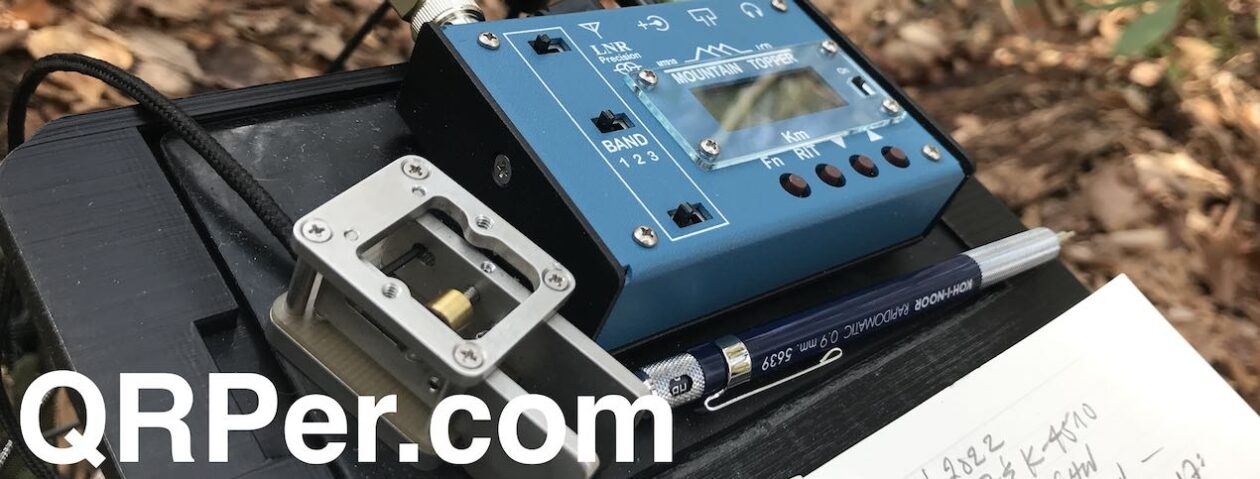Many thanks to Steve (KV4AN) who shares the following article about his portable field radio kit which will be featured on our Field Kit Gallery page. If you would like to share your field kit with the QRPer community, read this post.
KV4AN’s Elecraft KH1 Field Kit
by Steve (KV4AN)
The Elecraft KH1 is a new radio with less than two hundred delivered, so I thought the readers of QRPer.com may be interested in my take on a KH1 Field Kit.
The KH1 “Edgewood” package has everything necessary for 20-15 meter ultra-portable operation, such as pedestrian mobile, Summits on the Air (SOTA), or Parks on the Air (POTA). Elecraft put a lot of thought into it and like others have said, “I feel like it is the radio I always wanted.” However, I also wanted to be able to operate 40 and 30 meters and to be able to take it on a trip for a week; perhaps by air. There were three challenges that needed to be overcome to meet to do this: I needed an antenna for 40 and 30 meters, a way to recharge the battery, and everything needed to fit in one small protective case.

My solution was a field kit that had everything needed to operate 40-15 meters in the smallest possible hard case – the kit and components are shown in figures (1) and (2).

Components and Gear Links
The components of the KH1 Field Kit are listed below. Every piece had to “earn” a spot in the Nanuk 904 hard case. I tried the Pelican Micro M50 case, which is a little smaller than the Nanuk 904, but not everything would fit.
[Note: Most Amazon links are affiliate links that support QRPer.com at no cost to you.]
- KH1 Transceiver – A new ultra-small, self-contained, five-band, QRP, CW transceiver manufactured by Elecraft. The optional Edgewood Package includes a detachable keyer paddle, logging tray, ballpoint pen, ES20 carrying case, a telescoping whip antenna for 20-15 meters, and a 13 ft. counterpoise wire.
- ES20 Carrying Case – A custom soft case made by Elecraft for the KH1. Protects the KH1 and enables ultra-portable operation.
- Panasonic RP-HJE120-K Stereo Earphones – Used as miniature headphones. Fits in ES20 case.
- OLIGHT I3E-VROG-300000 Keychain Flashlight – Chosen for its extremely small size and orange color. Uses one “AAA” battery. Fits in ES20 case.
- Nanuk 904 Hard Case – This case was selected because it was large enough for the KH1 in its ES-20 soft case and all the gear in this list. The quality of the Nanuk case is very good.
- Tufteln EFRW Antenna – This antenna has a 31 ft. radiator and a 17 ft counterpoise. It was chosen because of its very small size when packed, good performance on 40 and 30 meters, and ability to be used with the KH1 internal tuner.
- Tufeteln Line Winder. This is Line Winder for the EFHW antenna kit, purchased separately to store the arborist throw line.
- Gerber Mullet Micro-Multitool – Chosen for small size. Has a Phillips and straight screw driver and a wire cutter/stripper.
- SOB 8 oz. Arborist Throw Bag –A durable arborist throw bag. This is a replacement for the Camnal Throw Bag pictured. Used to loft the antenna support line over a tree limb.
- X Monster Throw Line 1.8mm Easter Rope for Aborists, 50 ft. – Used to enable suspension of the end of a wire antenna from a tree.
- OXZEEWEE 12V 1A Power Supply Charger Adapter – a small wall-wart AC adapter used to charge the battery.
- Wisedry Desiccant Pack – 20 oz rechargeable silica gel pack – used to keep the inside of the sealed case dry.
- BNC to SO-239 Adapter – Enables use of coaxial cable with PL-259 connectors.
CONCLUSION
The Nanuk 904 Hard Case was the perfect size for all the things I needed for 40-15 meter operation on a muti-day trip and it is small and light enough to put in your carry-on bag for a flight.


























 These “No-Transformer” random wire antennas are designed to be paired with a good ATU–either external or internal. This type of antenna couldn’t be more simple.
These “No-Transformer” random wire antennas are designed to be paired with a good ATU–either external or internal. This type of antenna couldn’t be more simple.





























